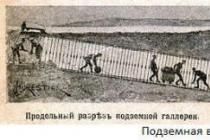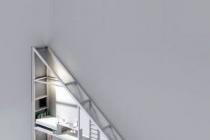Today, the use of the latest technologies in the construction of houses and industrial structures is very common. The use of old technologies now is practically not implemented anywhere. The constant demand for more and more new and advanced technologies left an imprint when laying the frame of the house, where new fiberglass reinforcement was needed for the foundation.
All kinds of foundations allow you to make it as strong and durable as possible. The operation of the foundation reinforcement with fiberglass reinforcement showed positive results and feedback from both builders and buyers. Such composite products have a number of advantages over others:
- Using the composition when fully immersed in water
- Fully moisture resistant
- Withstands drops and very high temperatures
- Not afraid of exposure to chemicals

Foundation structure using reinforcement
The foundation is the main and, perhaps, the most important part of any structure. Incorrect laying can lead to the fragility of the base and the complete deformation of the house. The use of reinforcement is often necessary to maintain and increase the strength of the foundation itself. Such fiberglass reinforcement for the foundation is fastened together into one frame, which will then be poured with concrete mixture to obtain a single monolithic slab.
To get a high-quality frame, you should think about purchasing a special tool that will allow you to quickly cope with the bending of reinforcement and its rods without losing quality.
At the moment, there are various fill options:
- Tape
- Columnar
- Monolithic
For the construction of residential buildings, a tape or monolithic variety is most often used. To create this kind of foundation, it is necessary to use reinforcement for the manufacture of the frame.
The variety of this kind of construction assortment, from the usual classics to the innovations of technological progress, is simply mesmerizing and baffles almost any buyer. Many do not even know half of these materials, although they are more convenient and practical than the classic old people of building materials.
One of the new implementations was the appearance on the market of fiberglass reinforcement. Not many people know what fiberglass reinforcement is and do not use it to the extent that it deserves it. It represents rods with a diameter of 4-20 mm and any construction length as required.
It is often used in the construction of civil, road and concrete structures with prestressed and stressed reinforcement of the base, instead of the usual classical reinforcement. Such fittings are practically eternal material, which is not afraid of any impacts and sudden temperature fluctuations. It can withstand enormous loads and is very maneuverable, which allows it to be used in the most difficult buildings. The selection of the required length greatly facilitates the installation and increases the strength of the structure, in comparison with the connecting characteristics of other fittings that are mounted by fastening to each other.
The benefits include:

Construction technology
For building strip foundation accurate calculations and a specific action plan are used. To begin with, they dig a trench in length from 30-80 cm. Its dimensions are calculated from the necessary data on measurements, the mass and area of the future structure.
Then, depending on the type of land, conditions and overall weight, the filling depth is calculated. The usual standard depth is 60-80 cm, but upon individual calculations, the depth of the strip foundation can be completely different.
A kind of cushion layer is created with the addition of gravel, which will improve the styling. It needs to be watered very hard. A fiberglass reinforcement is created for a strip foundation with an area of 10 mm. Its installation takes place on bricks or on other possible supports with the expectation that 5-10 cm remain from the bottom.
The initial rods are mounted with an accounting and programmed distance from the pit walls of 10 cm, then the vertical and transverse racks are tightly fixed with an equal interval of 40 cm. The first two upper rods of reinforcement are fixed on them and tied together with transverse rods.
The form (formwork) of the foundation is being made. To do this, an edged board 25 mm wide is taken, and rectangles of the required size are hammered out of it (taking into account measurements of the foundation), which should be about 30 cm above ground level.After that, a box is assembled from the prepared rectangles and installed in place of the foundation, put spacers and sprinkle the soil.
The finished form is poured with concrete. If support pillars were used, then they must be installed and precisely aligned with the level of the concrete pour. All this is done on the basis of calculations and data obtained.
Choice of materials
In principle, different materials can be used for the future structure. If the foundation has to be laid on the site of the groundwater site, then it is necessary to think about possible drainage channels and lay special waterproofing. To relieve pressure on brick wall and its base should be made wider than the width of the walls.
This is explained by the possible installation on poles and the phenomenon of a kind of solid sailboat under such conditions, and if the foundation is not too deep, then the supports may not withstand the load and pull out.
The reinforcement process is carried out using an equipped special hook and steel wire. Reinforced foundation can withstand a heavy load, and the fence installed on it can stand for many years.
Stages of foundation construction

For self-installation of the strip foundation, you need:
- accurate calculation of land characteristics
- data on climatic, tectonic and hydraulic data at the site of the future fence
- digging a trench spot
- calculation of fiberglass reinforcement for the foundation
- installation of the box
- formwork
- drainage and hydraulic channels (if necessary)
- waterproofing (if necessary)
- pouring the strip foundation with concrete
- drying out of the foundation
Any beginning of foundation installation begins with studying the area of the future installation: its characteristic ground and underground data, soil type, air humidity. The season for filling also plays a significant role.
It is preferable to perform such operations in the warm season, when periods of frost and rain have passed. When laying foundations in the fall or winter, you can get a bad, cracked foundation and poor support for the building as a result. Strict adherence to the calculations given for digging a trench will avoid mistakes and get a good result. When using a plywood sheet for formwork, it is possible to paint, which will be clearly visible for pouring concrete.
Summing up
As you can see from the list, making a strip foundation on fiberglass reinforcement is not difficult and does not require special knowledge. Having understood what fiberglass reinforcement is, everyone can significantly reduce their time and money for installing the box and at the same time win in the quality and strength of the material.
The only condition is the observance of the stage by stage during its construction. Each stage should begin after the complete completion of the previous one. When installing the foundation, calculations of depth, thickness are very important and a software calculation on a computer helps a lot in this. By calculating the future data in this way, you can significantly reduce the time for unnecessary measurements and unnecessary waste of materials.
The choice of materials for installation and manufacture also plays a significant role. It is worth giving preference to high-quality, certified material and components when receiving it. Usage good stuff and accurate implementation of the action plan is the key to obtaining a solid foundation in the future.
It is worth noting that the entire building and its future state will directly depend on the correctness of the foundation pouring, since it is the main support for the future construction and its installation should be taken as seriously as possible.
Fiberglass reinforcement is a building material created on the basis of bonded complex composition fibers. It is made on the basis of basalt, glass and carbon fiber, and they can be combined. However, the most popular are basalt-plastic reinforcement and fiberglass.
What is it made of?
It consists of two parts. The first one is the barrel, thanks to which the high strength of the material is achieved. The fibers are bonded together by the polyester resin of the composite. The outer layer serves for reliable adhesion to concrete: it is a fibrous body that is wound around the trunk in a spiral. It is thanks to this composition that the plastic reinforcement received positive reviews as a reliable material for construction. There are various variations of the rebar model, some of which are quite unusual. For the production of these building fittings, fiberglass is used. Its peculiarity is that there are practically no analogues in the world, and positive traits significantly expand the scope of application. In addition, this material is modern and efficient, and therefore meets the requirements of the construction process in the best possible way.
Any fiberglass reinforcement is based on two components. The first is the reinforcing material itself, the second is the binder (a mixture based on the ratio of these components - 75 to 25. In composite reinforcement, all mechanical loads fall on the reinforcing component, while the bonding materials are a kind of matrix that evenly distributes load on the entire length of the rod and protects it from external influences.
The most common recipe can be considered the following: glass roving or basalt fiber act as a reinforcing link, epoxy resin is used for bonding, in addition, a hardener and an accelerator will be included in the material. However, there is no universal composition, since each manufacturer builds its own technological process.
What is the secret of popularity?
It must be said that, compared to metal materials, plastic products are much more in demand today. Moreover, plastic fittings are used in any construction process. This is achieved through several qualities:
- Resistance to corrosion, aggressive environment, including the alkaline environment of concrete. Unlike metal, plastic does not rust or deteriorate. These qualities contribute to the fact that plastic structures are widely used when equipping berths, protective structures on water bodies.
- Reliability and strength, which is greater for plastic products than steel. It is the reliability that allows them to be used in the construction of building structures for various purposes and volumes.
- High tensile strength.
- Lightness of reinforcement: for example, compared to the steel version, the plastic one is five times less in weight and 11 times smaller in diameter. Such indicators indicate that you can save on construction work, as well as on the transportation of material to the object.
- Low thermal conductivity, due to which cold does not penetrate into the premises. It is no coincidence that more and more plastic reinforcement is used for the foundation: during its construction, it is possible to achieve high energy efficiency due to economical materials.
- Resistance to radio waves.
- Possibilities of application in various temperature conditions: from -70 to +100 degrees.
- Cost: buying a running meter of plastic reinforcement will be much cheaper compared to, for example, a one-meter piece of a metal rod.
Features of composite fiberglass
Composite fiberglass reinforcement appeared on the domestic market not so long ago and today is considered a new technology. Such plastic fittings also received good reviews, since they have a number of advantages over their metal counterparts. Firstly, such structures are lightweight, so there will not be too much load on the foundation, which means that the building will last much longer. Secondly, due to its high tensile strength, such reinforcement can be used for the construction of objects with complex design features. Thirdly, the composite material is resistant to aggressive environments and does not conduct electric current.

On the other hand, composite plastic rebar has a weaker modulus of elasticity compared to steel products. The elasticity is lost especially strongly when the composite is heated to 600 degrees. But on the other hand, it is this characteristic that speaks in favor of the fact that plastic reinforcement has also found application for the installation of the foundation, where tensile strength is very important.
Where are composites needed?
- In floor slabs: as a rule, the reinforcement is laid in the upper or lower zone of concrete, while the concrete class should be B25.
- When reinforcing concrete and reinforced concrete structures.
- When erecting foundations with a zero level of occurrence.
- In reinforced structures that are exposed to aggressive environments.
- During repair work associated with damage to concrete due to exposure to aggressive environments.
- For reinforcing brickwork, especially if it is done in winter.
Where is GRP rebar used?
The scope of application of this building material is extensive:
- For In view of the tensile strength, fiberglass is advisable to use it specifically for the construction of the base for objects. First, the installation will be simple. Secondly, the foundation will be solid. Plastic reinforcement for the foundation receives positive reviews due to the fact that it allows you to create a monolithic base. It is placed directly into the concrete slurry during the pouring process, due to which the adhesion of the materials becomes stronger. To prevent the formation of pores and cavities at the junction, specialists use special vibration equipment.
- When equipping high voltage power lines. Since the material is not conductive, energy will be lost to a minimum, while its operation will be safe.
- Plastic fittings receive positive reviews from builders due to their versatility. So, it can be used to strengthen the strength of the roadway, supports, bridges.
- Composite materials are at the heart of the production of sleepers. Due to the intense vibration under the influence of which the concrete disintegrates, it was necessary new material, and fiberglass reinforcement has become the correct and effective solution.
- The metal is not resistant to aggressive environments, high humidity, solvents and acids, therefore, its service life is not very long. Fiberglass, which is used in the construction of docks, berths, various barriers on the coastline, shows the best performance characteristics.
- Reinforcement made of plastic is also used in the equipment of mines when fixing a special mesh that protects the walls and arches of the mine from collapse and fixes them.
- You cannot do without this material when fixing the insulation or facing material on the finished wall.

Varieties of fiberglass reinforcement
Today, plastic fittings are used more and more often in construction due to their unique characteristics. In addition, composite reinforcement today is understood as a number of non-metallic structures, which significantly expand the scope of their application. So, modern manufacturers offer fiberglass and basalt-plastic fittings. At the same time, a variety of substances can act as polymer resins that bind fibers, each of which has its own characteristics.
Any building material is used based on certain rules and requirements. This also applies to composite reinforcement. Plastic fittings, the characteristics of which are so diverse, are used in construction based on SNiP approved back in 2003. By the way, each type of material is controlled by the manufacturing plant, and therefore the fittings must necessarily correspond to the parameters that were originally declared.
Foundation reinforcement: how to choose?
Today, in private housing construction, plastic reinforcement for the foundation is increasingly used. Experts advise when choosing it to contact authorized dealers and reliable manufacturers, since the strength and durability of the building as a whole will depend on the quality of the material. An important role is played by the quality of the product, as well as the density of winding of glass roving along the entire length of the rod. The turns must also be filled with good quality. Materials (edit) good quality- this is the best choice when equipping any foundation - slab, tape or columnar. The type should be chosen depending on what is the bearing capacity of the soil, as well as the load on the building as a whole.

Reinforcement of the foundation is necessary in order to make the loads on the base of the building more uniform during operation. Concrete is compressive strength, but its structural integrity can be compromised by stress. It is with the help of reinforcement that greater adhesion to concrete is achieved, respectively, the foundation becomes stronger and more reliable. The main requirements when choosing fittings should be the following:
- providing rigid adhesion to concrete;
- durability;
- flexibility;
- resistance to rust and corrosion.
The reinforcement can be working, that is, reducing stress and external loads, as well as distribution, when the load is evenly distributed on each rod - this helps to maintain the correct location of the working rods. With the help of clamps, the rods are tied into a frame, protecting the concrete from cracking. Transverse rods protect from the occurrence of inclined cracks in the foundation, and longitudinal ones from vertical ones.
Slab foundation
When erecting this type of base, you need reinforcement with a ribbed surface with a diameter of at least 10 mm. It is the diameter that affects how strong the reinforcement will be. Plastic reinforcement for the foundation, the reviews of which are so good, should be selected depending on the type of soil. For example, on non-porous and dense, that is, with good bearing capacity and resistance to deformation, the thickness and diameter can be small. If the house is massive, but on soft ground, the reinforcement should be thicker - about 14-16 mm. With this option, the reinforcement of the slab will be upper and lower, and the total number of bars will be more than 100. Knitting can be done in several ways. For example, first, reinforcement bars can be connected in the lower chord longitudinally and transversely, then vertical bars are attached to them, then again transversely and longitudinally. When knitting fiberglass reinforcement, it makes sense to use plastic clamps and ties. This is the so-called knitting of reinforcement with plastic clamps.
Strip foundation

Usually, strip base has a height greater than its width. Accordingly, due to its small size, the tape has a tendency to bend, and therefore, when erecting such a foundation, reinforcement with a smaller diameter can be used. The peculiarity of this base is that two reinforcement belts will be needed, no matter what its height will be. The process of laying the reinforcement will be as follows: rods are laid longitudinally in the upper and lower parts of the foundation at a distance of up to 5 cm from the concrete surface - they will bear the entire load in case of deformation. Reinforcement in several bars can be used for soft or moving soil, as well as when erecting oversized houses. Ideal for the construction of strip foundations, fiberglass reinforcement - grades f6 and f7 (for houses on one floor), grades f8 and f10 - for residential buildings with an attic or two floors.
Column foundation
Good plastic fittings (reviews confirm this) and during the construction of this structure. When reinforcing the posts, metal reinforcement with a diameter of 10 mm or fiberglass f6 is useful. It is better to choose reinforcement with a ribbed surface as vertical rods, and horizontal ones are needed only to tie the rods into a single frame. The reinforcing frame is 2-4 rods as long as the height of the pillar. For example, when reinforcing a column with a height of 2 meters and a diameter of 20 cm, four rods of f6 will be needed. They need to be placed 10 cm apart, and also tied with smooth reinforcement with a diameter of f4 or f5. For any type of foundation, you will also need fittings for plastic pipes.

Features of reinforcement knitting
The foundation is an important component of any building, its quality and reliability is a guarantee that it will stand for a long time and will serve reliably. Reinforcement of the base must be approached wisely. Consider how plastic reinforcement is knitted for a strip foundation, since it is he who is most often used in private housing construction. Knitting is needed in order to make the structure of the reinforcing cage uniform and more durable. The rods are tied at the places where they intersect. A piece of wire is bent in the middle, then it is put on a special hook, which is applied to the armature and tightened. An easier knitting method involves the use of plastic ties.
When creating a reinforcing system, plastic shut-off valves are important. Its main function is to contribute to a more durable and reliable fastening of plastic rods to each other. The most popular parts in this regard are clamps, which are special and contribute to the creation of a protective layer with a certain thickness in concrete. The plastic rebar clip is created by high pressure polyethylene casting. They are needed in order to securely fix reinforcing rods, frames in space, which will provide a protective layer in a concrete or reinforced concrete structure. The clamps can be used for horizontal and vertical surfaces, as well as for creating formwork.
How are plastic fittings made?
When deciding to build your home, pay attention to the many little things and start by building the foundation. Many are interested in the question of where to buy plastic fittings. Experts advise turning to trusted companies, since the durability of the service of the structure itself depends on the foundation of the house, its quality and reliability. Equipment for the production of fittings is quite expensive, and the quality of materials depends on its quality.
Plastic fittings, the production of which is carried out on high-tech equipment, can be produced in different diameters - 4-24 mm. Depending on the type of line, a different number of rods will be produced, as well as different sections. As a rule, the delivery set includes a whole range of devices - from a yarn heating device and an impregnation bath to a broaching device and a control cabinet. Thus, the equipment for plastic fittings must be selected correctly in order to make the technological process efficient.
Plastic fittings: customer reviews
In their reviews, the builders - experienced and not so much - agree on one thing: for the installation of the foundation, plastic fittings are just perfect. For example, some used a combination of steel and plastic rods: the foundation slabs and basement walls were made of plastic, and the floors, where stronger materials were needed, were built on the basis of steel. Many also note the convenience of knitting in comparison with metal fittings, which are supplied with one rod. In terms of tensile strength and resistance to decay, there is also no better plastic fittings.
But, on the other hand, it is not complete without negative reviews. True, judging by them, these shortcomings are still more than overlap with advantages. For example, it is believed that hands itch after working with fiberglass. In addition, it is almost impossible to bend it to make, for example, corners in the form of the letters G or P. At the same time, the manufacturers themselves focus on the fact that fiberglass reinforcement should be used exclusively for the installation of the foundation.

Steel or plastic: what to choose
For a beginner in construction, the choice of materials is always an important issue. For example, when designing a foundation, it is important to correctly knit reinforcement. Of course, in the case of building a bath, you can use simple metal rods, but what to choose for a solid house? Today there is a choice between steel and plastic structures, each of which has its own distinctive features and disadvantages. If we talk about the advantages, then they can be reduced to the following points:
As you can see, the plastic version has more advantages. The disadvantages of steel include: the occurrence of corrosion and heavy weight of the structure, while plastic reinforcement is only difficult in terms of bending. Thus, according to their technical specifications fiberglass reinforcement is in no way inferior to steel, while it costs less. On the other hand, it is very important to remember about the peculiarities of building a particular house. For example, if you need to connect the cladding material and the wall, then you can use plastic-based reinforcement. But when equipping concrete floors with reinforcement, it is better to use metal structures, since, due to their high weight, they will not float when concrete is poured. Thus, when choosing structures for reinforcement, several factors should be taken into account at once, which means that it is better to use the professional help of specialists.
Fiberglass reinforcement is a system of glued glass fibers, which uses a polymer composition as a binder.
It has a wide area of operation, so it can be used to reinforce any concrete structures. Due to its special characteristics, its main area of application is the reinforcement of concrete foundations in private households, for example, to equip a greenhouse, and in industrial construction.
Characteristics of polymer fiberglass reinforcement
According to GOST, fiberglass reinforcement for the foundation is produced with a cross section from 4 to 32 mm with a step of 2 mm. For the construction of private low-rise buildings, composite polymer reinforcement with a diameter of 6, 8, 10 mm is suitable.
For example, when equipping a greenhouse with a wooden frame, you can use the minimum indicators - 6 and 8 mm, since the weight of the greenhouse walls is insignificant.
Given the characteristics of a continuous reinforcing filler, plastic reinforcement for a foundation is of the following types:
- glass composite (ASK);
- carbon composite (AUK);
- combined (ACC).
The use of fiberglass reinforcement clearly shows that composite reinforcement exhibits the following technical properties:
- The maximum operating temperature is 60˚С.
- The ratio of force and cross-sectional area indicating tensile strength: ASK - from 800 MPa, AUK - from 1400 MPa.
- Ultimate shear strength across: ASK - from 150 MPa, AUK - more than 350 MPa.
- The maximum compressive strength is more than 300 MPa.
In addition, rods of the AUK class exceed ASK by almost 2.5 times in terms of tensile elasticity.
Rebar production technology
In its composition, composite rebar uses raw materials from epoxy resin and glass roving. They are are a strand of fiberglass... The line for the production of fiberglass rods goes through several production cycles.
At the initial stage, strands of fiberglass roving lend themselves to wetting with an epoxy compound. After that, the equipment for the production of fiberglass reinforcement performs the polymerization process - the impregnated strands of roving are pulled through a heated funnel-die.

The described polymerization technology is called pultrusion. In the course of its implementation, a rod of a given diameter with a smooth surface is obtained. To give the bar the traditional ribbed structure that is common in concrete construction, it is rolled between rollers, which are grooved or notched.
The production line produces rods of light yellow color, however, composite rebar and darker shades come across.
In everyday life, composite reinforcement is often called simply plastic.
This name is erroneous, since it does not reflect all the advantages of a material that is composite and has fiberglass fibers in its structure.
Advantages and disadvantages
Studying the reviews of private developers, the following advantages of a composite base over a steel one can be highlighted:
- the minimum weight is 8 times less than steel reinforcement, which does not give unnecessary load on the soil or pile foundation supports;
- corrosion resistance;
- low thermal conductivity;
- dialectical non-conductivity;
- tensile strength;
- durability;
- the possibility of strengthening aerated concrete.
The negative property of metal reinforcement is its high weight and susceptibility to oxidation, which minimizes its durability.
When installing it, it is necessary to follow clear rules, because the slightest contact with soil or precipitation causes one hundred percent corrosion. Fiberglass has zero exposure to moisture and minimal weight.
Comparison of metal reinforcement with polymer reinforcement shows that the former has a high thermal conductivity, which leads to the formation of cold bridges. The use of aerated concrete in combination with fiberglass rods provides additional protection against their penetration. Dialectic properties give many advantages of fiberglass reinforcement over steel.
The direct current, which is in the metal fittings, is the cause of the manifestation of oxidative processes in the material, since grounding is used to ensure the safety of working with it.

Leaving reviews, users note the convenience of transporting the material. The low weight in combination with the possibility of purchasing rods in coils makes the use of fiberglass reinforcement more convenient and in frequent households, in comparison with steel.
User reviews show that composite reinforcement is not without its drawbacks, among them:
- the material melts at temperatures above 600˚С;
- as the reviews show, electric welding is unacceptable;
- you cannot form the rods on your own, it is better to do this in production;
- the complexity of installation due to the possibility of injuring your hands.
User reviews
Alexander, 35 years old, Pskov
When the need to build a country house and a greenhouse was ripe, after listening to feedback and advice from friends, I bought fiberglass reinforcement instead of steel. The main advantages for me are that there were no problems with delivery (low weight) and a low price compared to metal fittings.
It was also easy for me to mount it - you can. It is easy to cut. Among the shortcomings in front of a steel base, I can single out the difficulty of working with bare hands.
Gloves are needed, because, while doing, I cut my hands on glass fibers. As for the bearing capacity, the material holds the walls of aerated concrete well. In general, fiberglass rods are an excellent replacement for traditional rods.

Sergey, 42 years old, Ryazan:
In principle, everything suited me. Polymer reinforcement came in handy for me. I took a 10-ku in a bay of 4000 m. I can note its low weight, with a diameter of only one and a half meters. Three of us were taken to the construction site.
We did it. The only thing is that you must definitely wear gloves, because the material cuts your hands, and they then itch. I cut the fittings under the greenhouse into pieces with a grinder. It turned out much faster than a hacksaw. I decided to knit with plastic clamps. I did it quickly.
It took a day to make a reinforcement for a 10 × 12 m greenhouse. I think this is a good replacement for conventional fittings. Especially if you need a low weight of the structure. For me, a comparison of steel and composite reinforcement showed an advantage towards the latter.
How to make a strip foundation for a greenhouse?
The greenhouse belongs to a low-rise, oversized structure and has a low weight, therefore, to reinforce its frame, rods with a cross section of 8 mm are suitable. The technology of arranging a strip foundation for a greenhouse includes the following stages:
- Calculation of the number of reinforcement.
- Installation and.
- Covering its cavity with glassine to ensure reusable structure.
- Designation of the mark of the level on which the filling will be performed. The mark is applied to the inside of the formwork frame and aligned with the line using the water level.
- Laying bricks on the foundation, which will make it easy to raise them by 5 cm from the bottom of the trench and formwork walls.
- Laying of two belts of reinforcement in the lower part and in the upper part of the formwork using solid rods.
- Laying of transverse reinforcement.
- Tying bars with plastic clamps.
- Pouring the base under the greenhouse with concrete.
As the reviews show, when laying a frame made of polymer rods, it is important to carry out anchoring. This is to secure their ends. There are several ways to do this:
- bend of the rod at the end;
- fastening an anchor type bolt to the ends of the rods. The length of the bent rod should be no more than 30 cm.
Installation of the frame of the foundation made of composite reinforcement (video)
Calculation of material consumption for the foundation
Reinforcement calculation is needed to identify the right amount rods to strengthen the foundation. To make a calculation for a slab base, it is necessary to determine the parameters of the rods, their length and number, taking into account the area of the foundation and the step of the reinforcing mesh. Since the monolithic foundation needs to be reinforced in two places - below and above - the resulting calculation must be multiplied by two.
To calculate the strip foundation, take the following parameters: tape width - 3.5 m, length - 10 m, casting height - 0.2 m, belt width - 0.18 m, bar diameter - 12 mm, number of rods in the casting - 2 horizontally and every 50 cm vertically. The perimeter of the foundation is 27 m, so the calculation of horizontal meters is done as follows: 27 * 2 = 54 m of reinforcement.
Calculation of vertical rods should be done as follows: 54/2 + 2 = 110 rods. In the frame, it will look like this: 108 rods with a step of 50 cm and two rods at the edges. The calculation must also include four more rods, one for each corner of the strip foundation. Taking a bar height of 70 cm, the calculation of the length of vertical bars will come out: 114 * 0.7 = 79.8 m.
In total, the strip foundation will require 54 + 79.8 = 133.8 m.
The construction market does not stand still, which leads to the emergence of new materials that have improved characteristics compared to analogues of the previous generation. More recently, fiberglass reinforcement appeared in the construction field, which has become a serious competitor to metal rods.
Until recently, steel reinforcement was the only material that was used in the production of reinforced concrete products to increase the strength of foundations and other elements of building structures. However, the new material is characterized by more perfect properties, which attracts the attention of the consumer.
Description of the material and its types
Fiberglass rebar is a non-metallic fiber-wound rod composite material or sprayed with fine abrasive powder. The diameter of the reinforced bars can be from 4 to 18 mm.
Depending on the material used as a basis for the manufacture of a bar, there are several types of composite reinforcement:

- Basalt products (designated by the letters ABP) are produced on the basis of basalt fibers bonded with organic resin. Such fittings are characterized by high resistance to aggressive media, including gases, alkalis and salts.
- Fiberglass reinforcement (abbreviation ASP) is made from fiberglass fibers bonded with thermosetting resins. The advantage of such rods is their low weight and high strength characteristics.
- Carbon fiber reinforcement (designation AUP) is produced on the basis of hydrocarbon. The material is characterized by increased strength, but has a very high cost, which significantly reduces its popularity.
- The combined products (abbreviation AKK) are based on basalt and fiberglass. This material is resistant to wear and tear and has a wide range of applications.
Among the listed types of composite reinforcement, the most popular are fiberglass products, so this particular material should be studied in more detail.
Advantages and scope of use of fiberglass reinforcement
In contrast to steel rods, fiberglass reinforcement has a number of significant advantages:
- Low weight, due to which it becomes more convenient to transport the material and perform various actions with it.
- High resistance to aggressive media, including gases, alkalis and salts.
- Resistance to the formation of foci of corrosion.
- High tensile strength.
All of the above characteristics significantly expand the scope of use of composite fiberglass reinforcement:
- With its help, walls and partitions made of bricks and various blocks are strengthened.
- With the help of fiberglass reinforcement, the load-bearing walls are connected to the facing partitions. By the way, we have an interesting article on the topic ““.
- Fiberglass reinforcement is excellent for strengthening and, the sole of which lies significantly below the freezing level of the soil. In addition, it is recommended to use composite reinforcement to reinforce foundations used in aggressive environments.
Fiberglass composite rebar can be used to reinforce any type of foundation for low-rise buildings. However, in the case of strip and columnar foundations for structures of no more than three floors, composite rods received many positive recommendations. In other words, fiberglass reinforcement can be used to strengthen a monolithic concrete tape for a private house or cottage in one or two floors, a bathhouse, a garage or outbuildings. On our site there is information about, and, as well as much more. You can use the site search to find the information you are interested in.
It is worth recalling that fiberglass reinforcement is a new material, the properties of which are not fully understood. Therefore, it is better to use the material for structural reinforcement, avoiding moments where increased bending and torsional strength is required.
Calculation of fiberglass reinforcement
Do-it-yourself foundation construction requires calculations of the amount of building materials, including composite reinforcement.
Taking into account various factors, the calculation of materials should be carried out according to the following algorithm:
- Determination of the total length of the foundation, taking into account the length of the internal load-bearing partition.
- Calculation of the length of the reinforcement rods, taking into account that the reinforcement will be laid in two tiers (4 rods).
- Determination of the number of connections. It should be borne in mind that the connection of fiberglass reinforcement rods is carried out not by welding, but with an overlap. Therefore, you need to add 1 meter for each corner.
- Performing calculations of transverse connections.

For a complete understanding, you can take an example of calculations of reinforcement for the foundation of a house measuring 6 * 8 meters, the internal load-bearing wall of which is 6 meters.
The total length of the foundation is determined as follows:
(6 + 8) * 2 + 6 = 34 meters.
The total length of the rods, taking into account the fact that the two-level structure consists of 4 parallel rods, is:
34 * 4 = 136 meters.
The number of connections and, accordingly, the length of the reinforcement for this purpose is determined as follows: the number of main walls is multiplied by 1 meter of overlap and by the number of rods. It turns out the following:
(4 + 1) * 1 * 4 = 20 meters.
Therefore, for the foundation of the indicated dimensions, taking into account the additional material for joining, the following number of longitudinal rods will be required:
136 + 20 = 156 meters.
You should also calculate the number of transverse ring joints. According to the technology of laying the reinforcing frame, the connecting rings should be located at a distance of 50 cm from each other. To determine the number of transverse connecting rings, the total length of the reinforcement must be divided by 0.5 meters. It turns out the following:
The dimensions of the frame are taken into account in order to calculate the length of reinforcement required for this number of cross members. For example, if the lattice of the frame has a size of 60 * 30 cm, then the length of the rod for one ring will be equal to the following:
(0.6 + 0.3) * 2 * 68 = 122.4 meters.
In addition, it is imperative to add a certain amount of material for the stock. That is, you should take not 122, but 130 meters of reinforcement.
Summing up the results of calculating the longitudinal and transverse elements of the frame, we get the result:
When choosing a material for reinforcing the foundation, all significant factors should be taken into account. Despite the large number of positive characteristics, fiberglass reinforcement is a new material, and metal rods are time-tested.
Fiberglass reinforcement "ARMASTEK" is made of fiberglass rods with a diameter of 4 to 16 mm, of any construction length (twisting into coils is possible) with a ribbed surface of a spiral profile, consists of glass roving bonded with a polymer based on epoxy resin. It must be used in industrial and civil, road construction, as well as in concrete structures with prestressed and non-stressed reinforcement, instead of traditional steel reinforcement.
For the successful use of fiberglass reinforcement in individual housing construction, we propose to use a special document - "Album of typical solutions for the use of non-metallic composite fiberglass reinforcement in concrete structures." The album presents reinforcement schemes for various types of foundations (floor slabs, lintels, columns) used in individual residential and commercial types of construction.
It is important to note that the use of fiberglass composite reinforcement increases the service life of structures (primarily foundations) in 2 - 3 times in comparison with the use of metal fittings, especially when exposed to aggressive media, including those containing chloride salts, alkalis and acids.
What should you pay attention to when choosing and buying fiberglass reinforcement?
It is necessary to buy fiberglass polymer composite reinforcement from manufacturers, official dealers of manufacturers and trusted suppliers authorized by these manufacturers.
When choosing fiberglass reinforcement, it is necessary to pay attention to the quality of the product, the quality and density of winding of glass roving along the entire length of the bar, and the quality of casting the turns. Beware of counterfeits when purchasing fiberglass polymer composite rebar!
High quality fiberglass reinforcement can be used for different types foundations - slab, strip, columnar. The type of foundation and parameters are selected depending on the bearing capacity of the soil and the load on the foundation. Here are examples of calculations for a house measuring 6 x 6 meters. According to this principle, the absolute majority of rectangular and square houses of any other required area can be calculated.
PLATE FOUNDATION: Calculation of the amount of reinforcement and tying wire
For a slab foundation, you need to use only reinforcement with a ribbed surface and a diameter of at least 10 mm, if it is metal, or at least f6 AKS (fiberglass). The strength of the entire structure depends on the diameter of the reinforcement: the thicker the reinforcement, the stronger. When choosing its thickness, you should focus on the weight of the house and the type of soil. If the soil is not porous and dense, i.e. has a good bearing capacity, then under load from the house it will deform less and less stability is required from the slab. The second factor is the weight of the house. The larger it is, the greater the load on the slab and the greater its deformation. If you are building lightweight wooden house on good soil, then reinforcement with a diameter of 10 mm will be enough to reinforce the slab. If the house is heavy on soft ground, then the reinforcement should be 14-16 mm thick. The step of the mesh of the slab's reinforcement cage is usually 20 cm, with such a step on our foundation of 6x6 m, 31 bars must be laid along and the same amount across, for a total of 62 bars. There are two reinforcement belts at the slab - an upper and a lower one, so the total number of bars will be 124 pieces, with a bar length of 6 m we get a flow rate of 124 x 6 m = 744 running meters of reinforcement. In addition, the upper mesh of the reinforcement must be connected to the lower one; this connection is made at the intersection of the longitudinal and transverse reinforcement bars. There will be 31 x 31 = 961 such connections. If the thickness of the slab is 20 cm, and the reinforcement frame is 5 cm from the surface, then for each connection you need a 10 cm long reinforcement bar (20 cm thick minus 5 cm from the bottom and top). All connections will require 0.1 x 961 = 96.1 meters of reinforcement. The total amount of reinforcement for the entire slab foundation will be 744 m + 96.1 m = 840.1 running meters.
To calculate how much knitting wire is needed, it is first of all necessary to determine the connection method: first, the longitudinal and transverse bars of the reinforcement of the lower belt are connected, then the vertical bars are attached to them, and then the longitudinal and transverse bars of the upper belt are connected to them. Thus, at every point where two horizontal rods and one vertical intersect, there are two knitting wire connections. There are 961 such places in the lower belt and the same number in the upper one. To knit one intersection of bars, you need 15 cm of knitting wire, bent in half, that is, 0.3 m of net length. The total consumption of knitting wire for a slab foundation will be 0.3 mx 961 x 2 = 576.6 m.
In the case of using fiberglass reinforcement the best option is the use of clamps and plastic ties (also used in telecommunication networks and electrical wiring).
TAPE FOUNDATION: Calculation of the amount of reinforcement and tying wire
The height of the strip foundation is usually much greater than its width: for example, width 30-40 cm, height 70 cm.In this case, the strip is much smaller than the slab, it is prone to bending, therefore, reinforcement of a smaller diameter can be used in the strip foundation. In the construction of individual houses, metal reinforcement 10-12 mm is mainly used, less often 14 mm. Another feature of the tape is the use of only two belts of reinforcement, regardless of the height of the foundation. In the upper and lower parts of the tape, 5 cm from the concrete surface, longitudinal reinforcement bars are laid, and they take the load upon deformation of the tape. Vertical and transverse reinforcement bars do not carry loads, they are made from thin and smooth reinforcement. With a strip foundation width of 40 cm, it is enough to use only four longitudinal bars - two on top and two on the bottom. Less commonly, reinforcement of three and four rods is used in each belt. Such reinforcement is justified on soft or moving ground or in the construction of massive houses. The best option for a strip foundation is the use of fiberglass reinforcement AKS f6, f7 for one-story houses, and AKS f8, f10 for two-story houses and houses with an attic.

The total length of the foundation tape under the house is 6 m by 6 m with one internal load-bearing wall will be 30 m (24 m perimeter of the outer walls + 6 m under the inner one). The consumption of ribbed reinforcement for longitudinal reinforcement in 4 rods will be 30 mx 4 = 120 m.Vertical and transverse rods can be installed with a step of 0.5 m.With a tape width of 30 cm and a height of 70 cm, taking into account an offset from the foundation surface of 5 cm by each connection will need 1.6 m of smooth reinforcement with a diameter of 6 mm (or fiberglass reinforcement AKS f4, f5). There will be 61 such connections, the total consumption of smooth reinforcement will be 97.6 m. Each such connection has 4 reinforcement bundles. One bundle requires 30 cm of knitting wire, so the total consumption of knitting wire for the strip foundation will be 0.3 mx 4 x 61 = 73.2 m.
COLUMN FOUNDATION: Calculation of the amount of reinforcement and tying wire
To reinforce the posts, metal reinforcement with a diameter of 10 mm or fiberglass reinforcement f6 AKS is sufficient. For vertical bars, ribbed reinforcement is used, horizontal bars are used only to tie them into a single frame. Usually the reinforcement cage for the post consists of 2-4 rods, the length of which is equal to the height of the post. If the diameter of the pillar is large (more than 20 cm), then more should be used, evenly distributing them inside the pillar. To reinforce a 2-meter column with a diameter of 20 cm, you can limit yourself to four rods made of reinforcement with a diameter of 10 mm (or AKS f6), which are located at a distance of 10 cm from each other and tied in four places with smooth reinforcement with a diameter of 6 mm (AKS f4-5). The consumption of ribbed reinforcement per one pillar will be 2 mx 4 = 8 m; length of smooth 0.4 mx 4 = 1.2 m.With the required number of posts 30 pcs, the total consumption of ribbed reinforcement will be 8 mx 30 = 240 m, and smooth 1.2 mx 30 = 36 m.

There are four horizontal rods in one post, each of which is attached to four vertical ones, therefore, to knit reinforcement for each post, you need 0.3 mx 4 x 4 = 4.8 m of knitting wire. The entire foundation of 30 pillars will require 4.8 mx 30 = 144 m.
COST OF FOUNDATION FITTINGS
Now, knowing the required amount of reinforcement in meters and knowing the weight of a running meter of reinforcement, you can calculate the required weight of the reinforcement and find out its cost. The average price of a ton of metal reinforcement is about 28,000 rubles, excluding delivery to the site. At the same time, it is important that for the transportation of metal reinforcement it is necessary to hire special transport (at least a freight GAZelle), and transportation of fiberglass reinforcement is possible on our own.
For slab foundation 6x6 houses need 840.1 m of reinforcement, with a diameter of 14 mm, the weight of one meter is 1.21 kg, the total weight of the reinforcement is 1016.5 kg. The cost of materials for reinforcing such a foundation is about 30,000 rubles.
For strip foundations you need 120 m of reinforcement with a diameter of 12 mm. The weight of one meter is 0.888 kg, the total weight is 106.56 kg. Reinforcement with a diameter of 6 mm needs 97.6 m, the weight of one meter is 0.222 kg, the total weight is 21.67 kg. The cost of materials for reinforcing such a strip foundation is about 4,300 rubles.
For a columnar foundation you need 240 m of 10 mm metal reinforcement, the weight of one meter is 0.617 kg, the total weight is 148.08 kg. A smooth reinforcement of 6 mm in diameter needs 36 m, its total weight will be 8 kg. The cost of the fittings is 5,000 rubles.

We bring to your attention a justification of the economic benefits of using fiberglass reinforcement for these purposes.
Calculation of the economic benefits of replacing metal reinforcement with fiberglass:
Pricing for GRP (used for foundations):
|
RUB 16.20 / r.m. |
|
|
RUB 22.80 / r.m. |
|
|
RUB 32.50 / r.m. |
|
|
RUB 40.80 / r.m. |
The cost of 1 ton of metal reinforcement is on average 28,000 rubles / ton, respectively:
|
Ø metal fittings |
Weight 1 r.m. metal reinforcement (kg) |
The cost of 1 r.m. (rub.) |
Replacement table:
|
Ø metal fittings |
Ø fiberglass reinforcement |
The savings in material cost (excluding the additional costs of transporting metal reinforcement) are as follows:
|
Price met. reinforcement for 1 running meter / rub. |
Glass price reinforcement for 1 running meter / rub. |
Savings in replacement from 1 r.m. / rub. |
|
Fiberglass fittings are cheaper, lighter and more reliable than their counterparts - metal fittings. It can be transported on its own - by light vehicles., in contrast to metal fittings.
It is important - when working independently with fiberglass reinforcement, it is necessary to use personal protective equipment for the skin of the hands and special clothing. When cutting reinforcement, it is necessary to additionally use personal respiratory and eye protection equipment.














